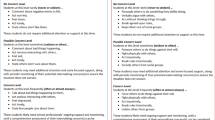Abstract
As the field of mental health services shifts its focus to early intervention, the need to develop valid and reliable measures of young children's behavioral functioning is clear. Traditional assessment instruments have focused on deficits, problems, and pathologies to the exclusion of strengths and competencies. However, assessing child strengths provides parents, direct service providers, and educators with a more holistic view of the child's functioning and an understanding of skills from which individualized treatment and education plans may be written. The Behavioral and Emotional Rating Scale (BERS; Epstein & Sharma, 1998) is a strength-based instrument designed to identify children's behavioral and emotional strengths. The psychometrics of the BERS has been demonstrated through several studies; however, the focus has mainly been on older age students. We sought to assess the convergent validity of the BERS with kindergarten children. The results of these two studies provide further support of the psychometric characteristics of the BERS and indicate its appropriateness with young children.
Similar content being viewed by others
References
Achenbach, T.M. (1991). Manual For the Child Behavior Checklist/4–18 and 1991 profile. Burlington: University of Vermont, Department of Psychiatry.
Day, M. & Hunt, A.C. (1996). A multivariate assessment of a risk model for juvenile delinquency with an “under 12 offender” sample. Journal of Emotional and Behavioral Disorders, 4, 66–72.
Department of Health and Human Services (1999). Mental health: A report of the Surgeon General. Washington DC: Author.
Epstein, M.H. (1999). The development and validation of a scale to assess the emotional and behavioral strengths of children and adolescents. Remedial and Special Education, 20, 258–262.
Epstein, M.H., Dakan, E., Oswald, D., & Yoe, H.T. (2001). Using strength-based data to evaluate children's mental health programs. In M. Hernandez & S. Hodges (Eds.) Tools, case studies and frameworks for developing outcome accountability in children's mental health (pp. 153–166). Baltimore: Paul A. Brookes.
Epstein, M. H., Harniss, M.K., Pearson, N. & Ryser, G. (1999). The Behavioral and Emotional Rating Scale: Test-retest and inter-rater reliability. Journal of Child and Family Studies, 8, 319–327.
Epstein, M.H., Hertzog, M. A., & Reid, R. (2001). The Behavioral and Emotional Rating Scale: Long-term test-retest reliability. Behavioral Disorders, 26, 314–320.
Epstein, M. H., Ryser, G., & Pearson, N. (in press). Standardization of the Behavioral and Emotional Rating Scale: Factor structure, reliability and criterion validity. Journal of Behavioral Health Services and Research.
Epstein, M. H., & Sharma, H. M. (1998). Behavioral and Emotional Rating Scale: A strength based approach to assessment. Austin, TX: PRO-ED.
Forness, S.R., Serna, L.A., Nielsen, E., Lambros, K., Hale, M.J., Kavale, K.A. (2000). A model for early detection and primary prevention of emotional or behavioral disorders. Education & Treatment of Children, 23, 325–346
Greenspan, S.I., & Meisels, S.J. (1996). Toward a new vision for the developmental assessment of infants and young children. In S.J. Meisels & E. Fenichel (Eds.), New visions for the developmental assessment of infants and young children (pp. 11–26). Wasington, DC: ZERO TO THREE.
Gresham, F.M., and Elliott, S.N. (1990). Social Skills Rating System manual. Circle Pines, MN: American Guidance Service.
Hammill, D.D., Brown, L., & Bryant, R.R. (1989). A consumer's guide to tests in print. Austin, TX: PRO-ED.
Harniss, M.K., Epstein, M. H., Ryser, G., & Pearson, N. (1999). The Behavioral and Emotional Rating Scale: Convergent validity. Journal of Psychological Assessment, 17, 4–14.
Kaiser, A.P., Hancock, T.B., Cai, X., Foster, E. M., & Hester, P.P. (2000). Parent-reported behavioral problems and language delays in boys and girls enrolled in head start classrooms. Behavioral Disorders, 26, 26–41.
Kaufmann, J.M. (2001). Characteristics of emotional and behavioral disorders of children and youth. (7th ed.). New Jersey: Prentice-Hall.
Landrum, T.J., & Tankersley, M. (1999). Emotional and Behavioral Disorders in the new millennium: The future is now. Behavioral Disorders, 24, 319–330.
Leffert, N., Benson, P.L., Scales, P.C., Sharma, A.U., Drake, & Blyth, D.A. (1998) On the measurement of inequality. Applied Developmental Science, 2, 209–230.
Meisels, S.J., & Atkins-Burnett, S. (2000). The elements of early childhood assessment. In J.P. Shankoff & S.J. Meisels (Eds.), Handbook of early childhood intervention (2nd ed.); pp. 231–257). New York: Cambridge University Press.
Merrell, K.W. (1996). Social-emotional assessment in early childhood: The Preschool and Kindergarten Behavior Scales. Journal of Early Intervention, 20, 132–145.
Mertens, D.M. (1998). Research methods in education and psychology: Integrating diversity with quantitative and qualitative approaches. Thousand Oaks, CA: Sage.
Oswald, D.P., Cohen, R, Best, A. M., Jenson, G.E., & Lyons, J.S. (2001). Child strengths and the level of care for children with emotional and behavioral disorders. Journal of Emotional and Behavioral Disorders, 9, 192–199.
Reid, J. (1993). Prevention of conduct disorder before and after school entry: Relating interventions to developmental findings. Development and Psychopathology, 5, 243–262.
Salvia, J., & Ysseldyke, J. (1998). Assessment (7th ed,). Boston: Houghton Mifflin.
Walker, H.M., & McConnell, S.R. (1995). The Walker-McConnell Scale of Social Competence and Social-Adjustment-Adolescent Version. San Diego, CA: Singular Publishing Group.
Walker, H.M., & Sprague, J.R. (2000). Intervention strategies for diverting at-risk children and youth from destructive outcomes. Emotional & Behavioral Disorders in Youth, 1, 5–8.
Author information
Authors and Affiliations
Rights and permissions
About this article
Cite this article
Trout, A.L., Ryan, J.B., La Vigne, S.P. et al. Behavioral and Emotional Rating Scale: Two Studies of Convergent Validity. Journal of Child and Family Studies 12, 399–410 (2003). https://doi.org/10.1023/A:1026059906344
Issue Date:
DOI: https://doi.org/10.1023/A:1026059906344



